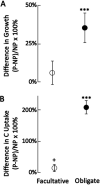The Functional Significance of Bacterial Predators
- PMID: 33906922
- PMCID: PMC8092244
- DOI: 10.1128/mBio.00466-21
The Functional Significance of Bacterial Predators
Abstract
Predation structures food webs, influences energy flow, and alters rates and pathways of nutrient cycling through ecosystems, effects that are well documented for macroscopic predators. In the microbial world, predatory bacteria are common, yet little is known about their rates of growth and roles in energy flows through microbial food webs, in part because these are difficult to quantify. Here, we show that growth and carbon uptake were higher in predatory bacteria compared to nonpredatory bacteria, a finding across 15 sites, synthesizing 82 experiments and over 100,000 taxon-specific measurements of element flow into newly synthesized bacterial DNA. Obligate predatory bacteria grew 36% faster and assimilated carbon at rates 211% higher than nonpredatory bacteria. These differences were less pronounced for facultative predators (6% higher growth rates, 17% higher carbon assimilation rates), though high growth and carbon assimilation rates were observed for some facultative predators, such as members of the genera Lysobacter and Cytophaga, both capable of gliding motility and wolf-pack hunting behavior. Added carbon substrates disproportionately stimulated growth of obligate predators, with responses 63% higher than those of nonpredators for the Bdellovibrionales and 81% higher for the Vampirovibrionales, whereas responses of facultative predators to substrate addition were no different from those of nonpredators. This finding supports the ecological theory that higher productivity increases predator control of lower trophic levels. These findings also indicate that the functional significance of bacterial predators increases with energy flow and that predatory bacteria influence element flow through microbial food webs.IMPORTANCE The word "predator" may conjure images of leopards killing and eating impala on the African savannah or of great white sharks attacking elephant seals off the coast of California. But microorganisms are also predators, including bacteria that kill and eat other bacteria. While predatory bacteria have been found in many environments, it has been challenging to document their importance in nature. This study quantified the growth of predatory and nonpredatory bacteria in soils (and one stream) by tracking isotopically labeled substrates into newly synthesized DNA. Predatory bacteria were more active than nonpredators, and obligate predators, such as Bdellovibrionales and Vampirovibrionales, increased in growth rate in response to added substrates at the base of the food chain, strong evidence of trophic control. This work provides quantitative measures of predator activity and suggests that predatory bacteria-along with protists, nematodes, and phages-are active and important in microbial food webs.
Keywords: 18O-H2O; Bdellovibrio; food webs; predator; qSIP; stable isotope probing; top-down control; trophic interactions.
Copyright © 2021 Hungate et al.
Figures




Comment in
-
Bacteria on the hunt.Nat Rev Microbiol. 2021 Jul;19(7):406. doi: 10.1038/s41579-021-00576-x. Nat Rev Microbiol. 2021. PMID: 33986534 No abstract available.
References
-
- Steichen SA, Brown JK. 2019. Real-time quantitative detection of Vampirovibrio chlorellavorus, an obligate bacterial pathogen of Chlorella sorokiniana. J Appl Phycol 31:1117–1129. doi:10.1007/s10811-018-1659-z. - DOI
-
- Jurkevitch E, Davidov Y. 2007. Phylogenetic diversity and evolution of predatory prokaryotes, p 11–56. In Jurkevitch E (ed), Predatory prokaryotes. Microbiology monographs, vol 4. Springer, Berlin, Germany.
-
- Gumbo RJ, Ross G, Cloete ET. 2008. Biological control of Microcystis dominated harmful algal blooms. Afr J Biotechnol 7:4765–4773.
